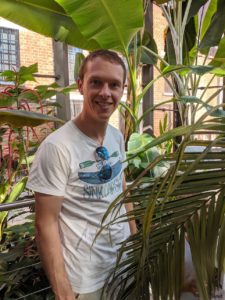Graham White graduated from the University of Exeter in BSc (Hons) Computer Science and Management Science in 2000, and has been working for IBM for 20 years since joining their graduate programme.

I work for IBM in the world-renowned IBM Research division. My focus is applied research within the Emerging Technologies group. In this role, I generally take new technology to our clients as part of a first-of-kind project which is always hugely interesting and very exciting. It is extremely varied as I can be talking to a client about a particular solution in the morning and in the afternoon I might be working on some fundamental research with my university partners. Hence, people in my job are typically very broadly knowledgeable and enthusiastic about technology but also have at least one area of deep technical skill.
It’s hard to pick just a few, but I wanted to share 3 projects I’ve been involved with in recent years:
- I was involved with creating a system to automatically translate spoken English into British Sign Language. The project was created by IBM interns under the Extreme Blue programme (for which I would encourage everyone reading this to consider signing up to) that hooks up experienced technical people from IBM to mentor students during a summer project. Rather than describe it in detail, take a look at this 15 second clip to get a rough idea or listen to Helen explain it. Helen has since gone on to become one of the managers in my department. This is still one of the project we get asked about on a regular basis.
- During 2018 I worked on a system to enhance rail travel codenamed Stepping Stone for people with disabilities and older people. This group of passengers find it harder to travel by train, and can often be extremely anxious while travelling. My solution was to create a mobile application that walks the passenger through their journey but does so by continuously linking them with a member of staff. So they can ask questions, get help, meet up with passenger service assistants and anything else they want at any point during their journey. It’s a bit like a WhatsApp type of interface where people can chat to station staff and staff on the train. It detects when they arrive at a station and contains a lot of features resulting from accessibility research so it can be used by people with visual or hearing difficulties, people with physical disabilities, learning difficulties, or older people.
- A more commercial example of something very creative I’ve done is through our partnership with the Knorr food company. They approached us for help with a marketing campaign and through a period of consulting with them we came up with the idea of profiling flavours. The idea and tech we needed to implement involved working out the flavour profile in two respects: how people experience flavour and which ones they prefer; and which flavours different foods contain. In a broad sense, this allowed us to come up with a mapping between preferred flavour and different foods. It allowed Knorr to recommend certain products to particular individuals based entirely on the science behind which flavours they are most likely to enjoy.
To give a little more background to my career, starting from when I graduated with a Computer Science and Management Science degree, I still wasn’t entirely sure what career I wanted. I had narrowed my options to management consulting or computer programming. I applied for a few roles but was really attracted to IBM as it fitted my preference of a more technical job. After a 1 day interview in London and 2 day assessment centre in Winchester I was offered a place on the graduate scheme and started work at the rather lovely IBM Hursley on 4 September 2000. The site has a similar stately home history and campus feel to it as the Streatham Campus.
I formed the first Linux support team when the company invested $1 billion in transforming the IBM product line to work on Linux. My job was to provide support to the 3000 people working on site and consisted of being away from my desk a lot, either in a huge machine room working on servers or at people’s desks helping them more directly with one-to-one support. Since then, I have worked in a number of different roles that have taken me around the world. I have set up and worked on some of the world’s fastest super computers (they all run Linux); helped scientists crack some particularly hard problems such as mapping the human genome, weather prediction, seismic surveying and nuclear simulation; worked on teaching computers how to understand human speech, something we now fashionably call machine learning or artificial intelligence.
For more information about careers at IBM, see our website: https://www.ibm.com/uk-en/employment/
